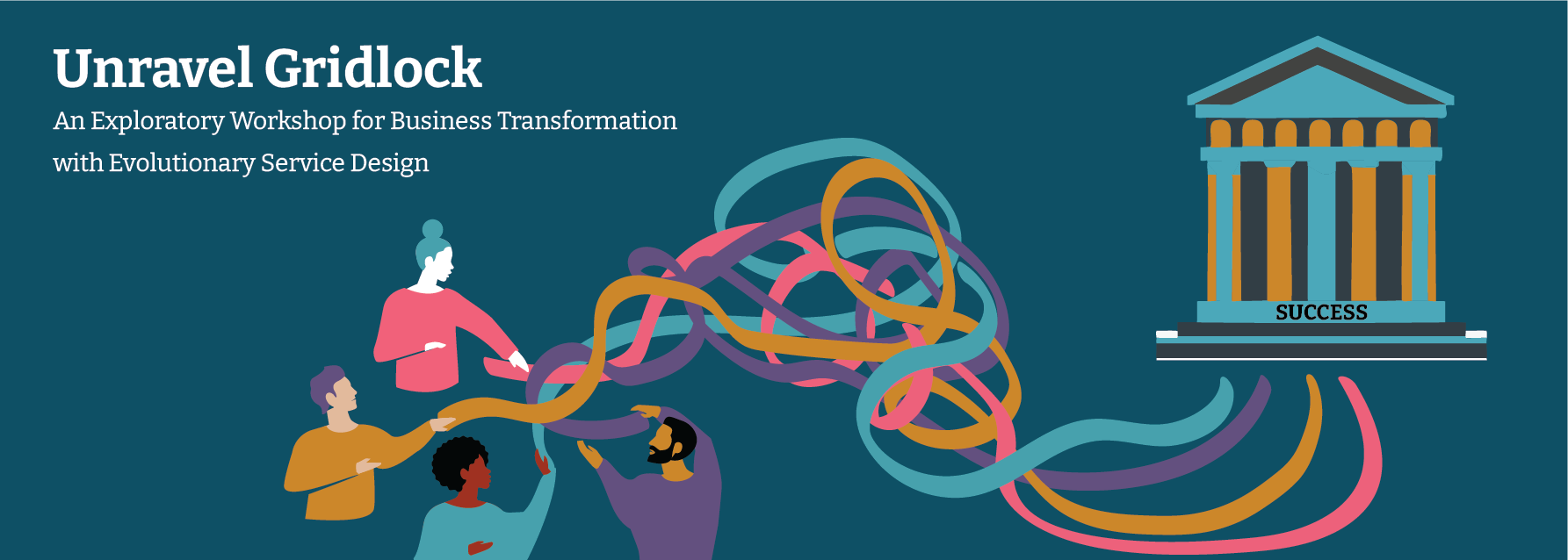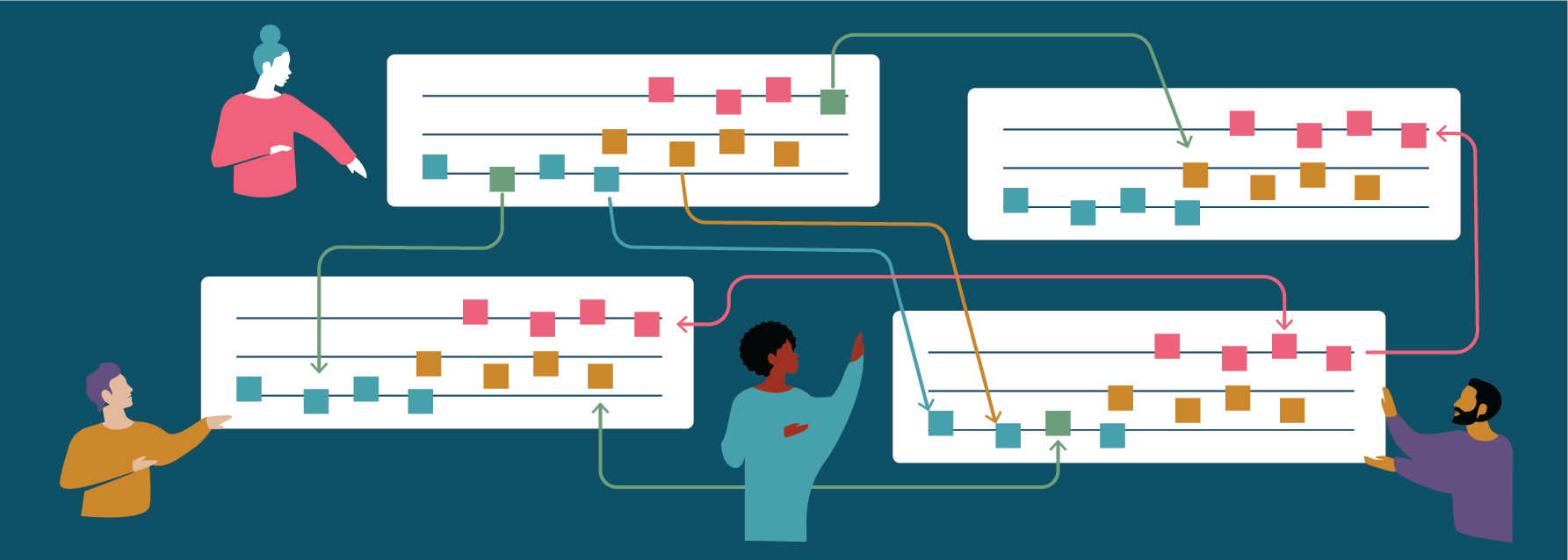

"We are at an impasse. We need to make this work."
The journey of business transformation is hard. The complexity and scale can be overwhelming, leading to challenges that rapidly snowball into what can feel like a series of impenetrable mazes. When progress stalls, leaders must find solutions to break through organizational gridlock, increase speed of delivery and ensure success.
Evolutionary service design is a collaborative approach that empowers teams to overcome gridlock in any scenario. It is especially transformative when organizations transition from project-based operations to agile, product-driven ways of working that put user experience at the forefront every step of the way.
Rather than working from static blueprints that only describe an ideal end-state, evolutionary service design enables teams to capture current and transitional states as well. This is essential in complex ecosystems with many unknowns and iterations that change dynamically over a long timeline. Teams are empowered to co-own blueprints and systematically refine them on an ongoing basis.
Underpinning this method are important strategies for collaboration, prioritization and leadership which, as a whole, collectively help the entire organization overcome obstacles. In this article, we map out these methods through the journey of a client in the automotive industry.
"We have to be brave."
Organizations often decide to undertake the mammoth task of transformation to take advantage of recent developments in technology, increase their competitive edge and ensure robust, efficient pipelines for years to come. A recognized global leader in luxury automotive, one of our clients decided to launch a comprehensive transformation of its used cars business for similar reasons. With this business area making up a significant portion of overall revenue, the pressure to deliver a successful transformation was immense.
However, approximately a year into this program, the organization found themselves in a transformational quagmire, bogged down in a mudslide of complex questions and unable to make significant progress.
Our Thoughtworks team was tasked with unblocking the program.
Challenges we observed
As we conducted interviews with key stakeholders, we realized that the program’s challenges were the culmination of multiple factors:
A tendency towards extensive upfront analysis and waterfall decision-making led to tasks defined with too broad a scope and with too much complexity for teams to tackle efficiently.
Planning and execution remained rooted in project-based milestones rather than oriented to customer value.
Parallel intertwined company initiatives competed for resources and made prioritization unclear.
Roles and responsibilities were not clearly defined. Either it was unclear who had ultimate accountability for decision-making or there was too much dependency on high-level management to make low-level decisions.
Stakeholders and product team leaders were asked to simultaneously manage current operations while developing future processes. Not enough capacity was given for the challenging work of building the products and services critical to the success of the transformation.
An extensive set of business process designs defined at the beginning of the program laid out target scenarios, but failed to provide sufficient guidance for prioritization and decision-making.
Any given part of each process design could represent a flow that was either pre-existing, in-progress, or a theoretical scenario for the distant future. Unfortunately, it was not possible to tell from the diagrams at what state the processes were in at any given time.
It was also not possible for teams to note when interim solutions needed to be put in place, or where there were open questions that needed to be resolved.
These factors collectively led to people feeling constantly overwhelmed and frustrated. It became virtually impossible to get work moving. Where everyone agreed was in the pressing need to find a compass to lead them forward, transform existing patterns and kick-start long-term change.
So the program sought out a new master service design blueprint, which they hoped would give enough alignment to provide pathways out of gridlock. However, when the program attempted to drive development through up-front business process designs, it proved to be inadequate for overcoming their challenges.
“Continuing like this is not an option.”
Our method: introduce evolutionary service design
To model a more agile mindset and interactive way of blueprinting, we developed a method called evolutionary service design, which is a way of mapping that promotes co-creation, iteration, and continuous alignment. Thus, we introduced the idea of a blueprint as a living, evolving collaborative working document rather than a static artifact.
Instead of having a few designated people draft a blueprint at the beginning and then hand them off to the teams for implementation; team leads, subject matter experts, and technical staff were encouraged to take ownership and contribute to designing the systems and processes on an on-going basis. Alignment and updates to the blueprints were encouraged to happen regularly in cycles of 4-6 weeks. The blueprints had a built-in rubric for documenting various states, open questions, potential risks and other considerations.
The method also instills user-centricity in the form of roleplay and user stories, reminding teams to consider the needs of the users involved in the processes they are building at each iteration.
This way of working enabled teams to break large complex challenges down into smaller achievable tasks, which is key in unraveling program gridlock. It also helped them gauge the value and complexity of each challenge, and therefore prioritize which to tackle first.
Initial remote working sessions
In the beginning, due to the distributed teams, on client’s request we ran online work sessions with one product team, with the goal to familiarize the team with our method.
After several remote sessions, we found that collaboration was successful in a small group. It also strengthened the view that some form of process-mapping would be valuable.
However, the program’s existing challenging dynamics kept resurfacing in these online workshops. The client team’s suggestion to include more people, made the high number of dependencies more apparent and dynamics more complex. The scope tended to inflate as participants continually added up issues they felt were urgent. In addition, the online format supported a passive rather than participatory dynamic, making it difficult to encourage attendees to collaborate hands-on.
As a result, they were caught in a vicious cycle. Given these challenges, we decided to pivot our approach to make the shift in method and ways of working more effective.
Pivoting our approach: bring everyone together in person
Leveraging the power of in-person collaboration to figure out complex problems collectively, we ran a two week in-person workshop where product leads and subject matter experts could develop processes and identify challenges together. The objectives of the workshop included:
Map the current as-is-state of existing business processes as well as near future implementations, and identify and prioritize problem points.
Create end-to-end understanding across product clusters, recognize connections and dissolve siloed thinking.
Give product leads the stage to assume accountability and decision-making powers, while clearly designating other supporting roles.
The bonding and rapport built during the workshop laid a strong foundation for communication. This is critical for service design to deliver the program breakthroughs on an ongoing basis throughout the project’s lifetime. To be effective and evolutionary, service design must be fundamentally agile and driven by teams.


"This is an exceptional format, which helped us to increase transparency and shared understanding."
The workshop was a resounding success. Participants and stakeholders alike voiced positive feedback, team spirit reached an all-time high, productivity skyrocketed and participants gained a new shared understanding of the challenges ahead.
The success factors
Key success factors of introducing evolutionary service design methodology that fits our client’s context include:
The definition of a common language: Our methodology delineated between as-is, in-progress, and to-be states, as well as defining technical tools used, estimated throughput, risks and connections across product clusters. This provides a common ground to create the blueprints starting with the current state, and provides more clarity on the maturity of the content in the defined blueprints.
Collaboration enabled by clear ownership: We established that these maps were owned by the product leads but developed in collaboration with subject matter experts, IT specialists and the other leads. The goal was set to learn experientially the nuts and bolts of creating a connected set of evolutionary blueprints. This eliminates endless discussions of who carries ultimate responsibility, and makes the approach highly collaborative.
Treat the blueprints as working documents: The blueprints are living documents which are continuously annotated and adapted to the shifting landscape of development. This helps release the pain of a “big-bang approach” involving too large a scope, with teams constantly feeling that they are still missing other pieces.
There also some other things that helped us achieve these outcomes:
Ensuring buy-in from leadership
Support from leadership in terms of time and resources is essential for success. In leading by example, leaders demonstrated courage to change, fostering trust, positivity and motivation, which enhanced a sense of security and collaboration.Limiting scope
To give everyone a definitive starting point, focus on one scenario first. Although this requires setting other topics aside, it is necessary to cut down complexity in the beginning. In our case, we limited the scope to only one major market and one business case.Agreeing a set of rules
We established ground rules for the workshop beforehand, focusing on real-world processes, avoiding deeper technical discussions, and adhering to the assigned roles. These clear directions provided clarity and guidance for the participants.Articulating problem statements and prioritizing them collaboratively
Create effective, user-centered problem statements and rate them according to business value, urgency and complexity (a method similar to “WSJF” - “weighted shortest job first”). This approach assigns each problem a relative score, that helps to prioritize those with high value and low complexity (immediate wins).This method demonstrates that it isn't practical to immediately tackle what's perceived as the most urgent challenge. This is because complex problems first need to be broken down into actionable packages.
Define roles and responsibilities per problem space
To facilitate handling problem topics, participants were asked to assign roles* for each key area of their program and elaborate on their thought process, providing a platform for discussion and alignment.
- Know when working in-person is key
In certain scenarios, remote working can exacerbate gaps in communication and lengthen the time it takes to identify risks and solutions.
"I am deeply impressed by the workshop outcome, and the effect is long-lasting. For me it is a breakthrough in our work".
"After the workshop, now I feel that we are really one team".
"The workshop has helped us to reach the absolute all-time high team achievement".
Conclusion
Any business transformation is a journey that takes training, clear and continual communication, iteration and time. But with the right strategies and a strong foundation, this journey need not be slow, risky and painful. The road to transformation can be energizing and dynamic, where people feel empowered to take the necessary steps towards change and are rewarded with the satisfaction of seeing their work come to life.
Evolutionary service design in tandem with bold leadership and a supportive culture, gives organizations an agile approach to mapping user journeys and business processes. This provides critical visibility into the as-is state of development and the flexibility to adapt in order to avoid pitfalls, accommodate new business needs, and apply lessons learned. This is key in enabling a team and organization to unravel gridlock.
This gives an organization resilience in the face of complex challenges and unforeseen events. It brings clarity and alignment in times of confusion when difficult but critical decisions must be made.
“Beyond the methodologies and tools, it was also tremendously valuable for us to so closely experience the Thoughtworks culture and ways of working.”
(All quotes are paraphrased from actual client comments documented during the engagement.)
* Roles included those responsible, accountable, consulted, supporting, and informed (RASCI).

















